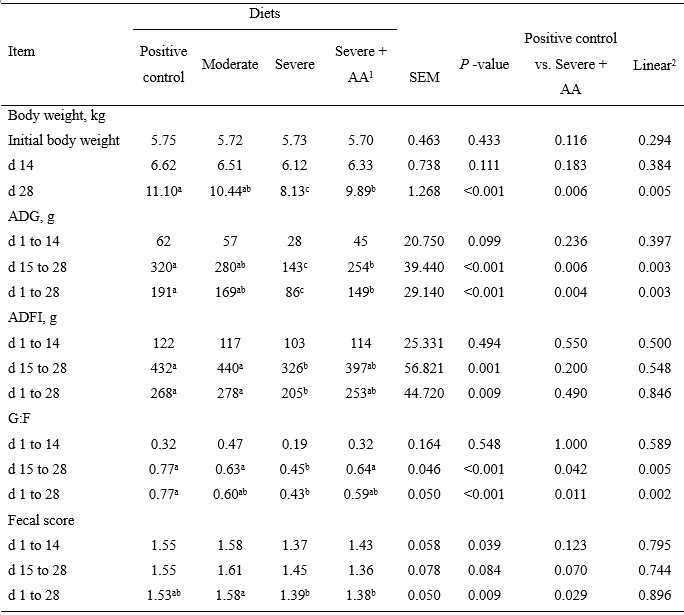Excessive heat during processing can reduce the concentration and bioavailability of Lys in soybean ingredients via Maillard reactions, lowering growth performance in weanling pigs. Reactive Lys (the Lys not bound in Maillard products) is the relevant bioavailable part of Lys that can be used for protein synthesis by the animals. We tested the hypothesis that: (1) growth performance can be predicted from reactive Lys supplied by heat-damaged soybean ingredients, and (2) crystalline amino acids (AA) can be added to the diet to compensate for heat-induced losses.
Experimental Design
One batch of conventional soybean meal (SBM) and one batch of enzyme-treated soybean meal (ESBM) were each split into three batches and were either not autoclaved, moderately autoclaved (120 ± 1 °C; reactive Lys ≈ 85% of total Lys), or severely autoclaved (120 ± 1 °C; reactive Lys ≈ 70%). Four phase 1 and four phase 2 diets were formulated: 1) Control (non-autoclaved SBM and ESBM); 2) Moderate (moderately autoclaved SBM and ESBM); 3) Severe (severely autoclaved SBM and ESBM); and 4) Severe + AA (severely autoclaved SBM and ESBM with crystalline AA to match digestible AA and reactive Lys in the control diets. Phase 1 diets were fed from day 1 to day 14 and phase 2 diets were fed from day 15 to 28.
One hundred and sixty weanling pigs with an initial body weight (BW) of 5.71 ± 0.55 kg were allotted to a randomized complete block design with two blocks of 20 pens (4 pigs/pen; 2 barrows, 2 gilts).
There were five replicate pens per treatment in each block for a total of ten replicate treatments in the two blocks. Pigs were weighed on days 1, 14, and 28. Daily feed allotments were recorded and feed left in the feeders was recorded on days 14 and 28. At the conclusion of the experiment, average daily gain (ADG), average daily feed intake (ADFI) and gain to feed ratio (G:F) were calculated. Fecal scores were assessed every other day. The statistical model included diet as a fixed effect and block and replicate within block as random effects. Contrast coefficients were used to compare the control diet and the severe + AA diet, and the linear effect of decreasing reactive Lys in diets was also calculated.
Results
In SBM, autoclaving increased reducing sugars (glucose, fructose) and decreased sucrose, stachyose, and raffinose; ESBM contained < 0.05% reducing sugars and oligosaccharides regardless of heat treatment. The Lys:crude protein (CP) ratio decreased when autoclaving time increased in SBM, from 6.63 to 6.07 and 4.70 and in ESBM, CP:Lys was reduced from 6.24 to 5.62 or 4.99. Reactive Lys was reduced in SBM from 2.84% to 2.54% and 1.59 %, and in ESBM from 3.11% to 2.72% and 2.38% as autoclaving time increased. Trypsin inhibitor activity decreased to less than 0.45 TIU/mg in both ingredients with the most severe autoclaving treatment.
By day 28, pigs fed the diets with severely autoclaved SBM and ESBM had reduced BW compared with pigs fed control diets (P < 0.001; Table 1). From day 1 to 14, ADG tended to be less by pigs fed the diet with severely autoclaved SBM and ESBM compared with pigs fed the other diets. From day 15 to 28 and overall, pigs fed the control diet had greater ADG than pigs fed the diets with moderate or severely autoclaved SBM and ESBM (P < 0.001). Average daily feed intake from day 15 to 28 and from day 1 to 28 was also reduced (P < 0.05) by pigs fed diets with severely autoclaved SBM and ESBM compared with pigs fed the control diets. The G:F in phase 2 and overall was greater (P < 0.001) for pigs fed the control diets compared with pigs fed diets with severely autoclaved SBM and ESBM. Adding crystalline AA to the diets with severely autoclaved SBM and ESBM improved (P < 0.05) final BW, ADG, ADFI, and G:F compared with pigs fed the diets without AA, but pigs fed the control diet had greater (P < 0.05) final BW, ADG, ADFI, and G:F than pigs fed the diet with autoclaved SBM and ESBM and synthetic AA.
Fecal scores were low regardless of treatments, but pigs fed the diet with severely autoclaved SBM and ESBM had firmer feces compared with pigs fed the control diet (P < 0.05).
Conclusions
Heat treatment reduced Lys, reactive Lys, and other indispensable AA in SBM and ESBM, and diets formulated without accounting for this loss reduced ADG, ADFI, G:F, and final BW. Crystalline AA supplementation partially mitigated the negative effects of heat damage, but did not fully restore performance, indicating additional heat-damage consequences, which may be related to reduced energy digestibility.
Key Points
- Heat damage reduced Lys:CP and reactive Lys in SBM and ESBM.
- Reduced dietary reactive Lys caused linear declines in ADG, G:F, and final BW.
- Crystalline AA partly restored performance for pigs fed diets with severely heat-damaged SBM and ESBM.
Table 1. Growth performance and fecal score of pigs fed experimental diets

1 AA, amino acid; ADG, average daily gain; ADFI, average daily feed intake; G:F, gain to feed ratio.
2 Linear effects of decreasing reactive Lys in the positive control, moderate, and severe diets.